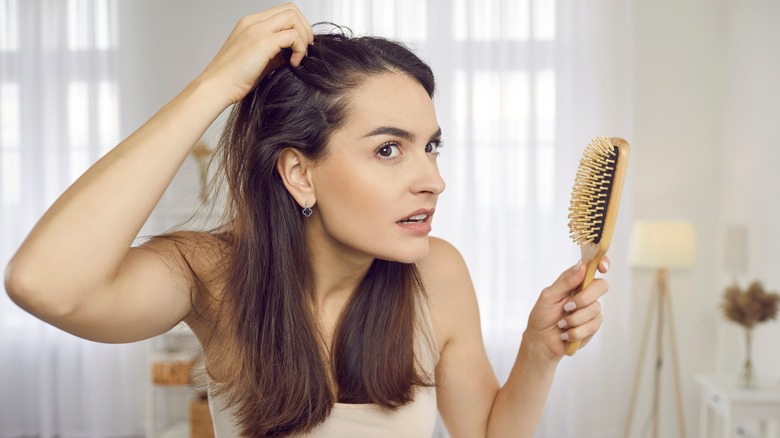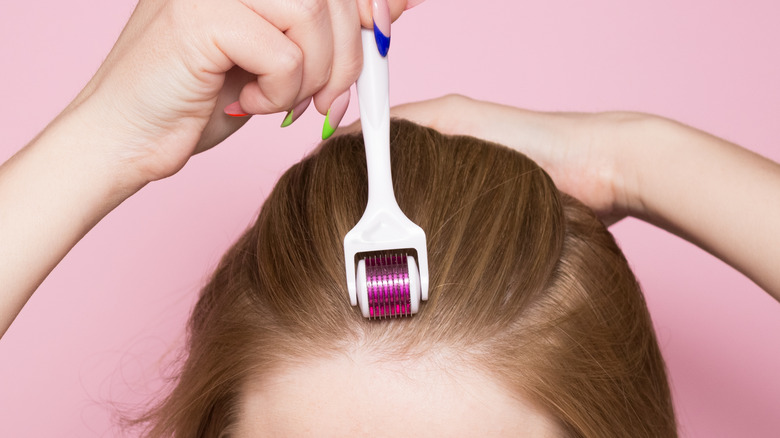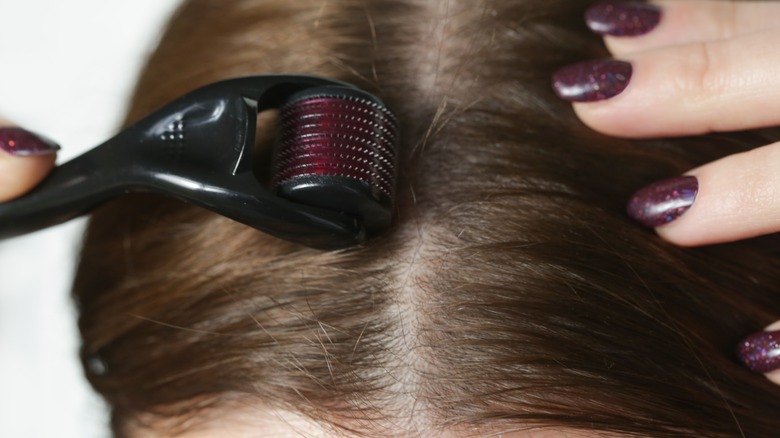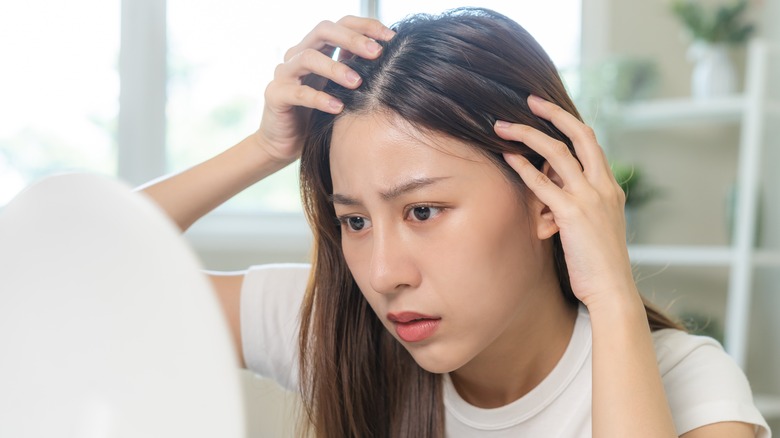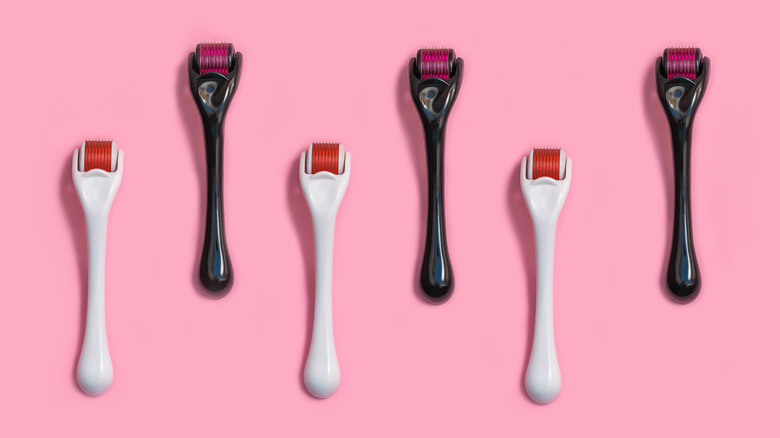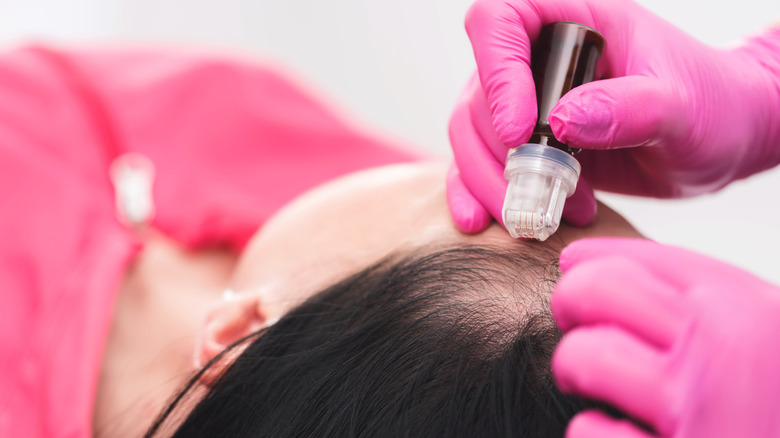Does Derma Rolling Actually Work To Combat Hair Loss? The Benefits & Drawbacks, Explained
Long, healthy, luscious hair has always been closely intertwined with sex appeal and sensual allure. Many of us lust over thick, shiny hair and dream of beautiful curls effortlessly cascading down our shoulders. Many of us successfully hide the thinning with hair styling tips. If any of these resonates with you, then keep on reading. If they don't, then consider yourself as one of the truly lucky ones, blessed with hair that the rest of us strive to achieve and fantasize about.
However, if you side with the less fortunate ones and experience thinning hair or even hair loss on the skin, beard, or scalp, then you might have heard of the derma roller technique. A derma roller is a handheld tool that has a roller covered with tiny thin needles made of medical-grade titanium or surgical stainless steel. Depending on your choice of a dermal roller for DIY use, the needles vary in length ranging from 0.2 to 1.5 millimeters.
To awaken those hair follicles, you use the tool and roll it on the affected area to create tiny punctures on the skin. When used on the skin or scalp, the derma roller causes trauma to the respective area and activates the skin's natural healing process stimulating hair growth. Derma rollers have been the true buzzwords lately used for skin and hair purposes, but do they actually work? And if they do, do the benefits outweigh the drawbacks?
How do derma rollers work?
While all the fuss is about this nifty little tool, you actually have to use it with a hair growth-stimulating product to actually see an improvement. Typical ingredients in such products include castor oil, argan oil, coconut oil, retinol, and redencyl. Minoxidil (Rogaine) — an over-the-counter product that comes in shampoo, serum, or foam — is also widely used to treat thinning locks and hair loss.
As you apply the derma roller across your scalp (or skin or beard), the needles make tiny dot-like holes in the skin, thus allowing the hair product (usually gel or oil) to reach the follicles. Since the product goes deep into the root of the hair, the effect is more potent, as opposed to simply applying the product on unperforated skin. In addition, the tiny needles come into contact with the hair follicles, essentially awakening the stem cells, nudging them to start working again. Moreover, the micro-injuries caused by the needles trigger the body to produce collagen, thus stimulating hair growth and making the hair fuller and healthier. As more blood flows in the punctured area, more nutrients, such as platelets, come with it, nourishing the skin and assisting in hair growth.
The benefits of using a derma roller
A 2021 research study published in the Journal of Cosmetic Dermatology comparing the use of derma rolling versus Minoxidil highlights the benefits of this method. More specifically, the study results suggest that using a derma roller to stimulate hair growth is more effective than simply using Minoxidil. The combination of derma rolling and Minoxidil was even more potent, resulting in increased hair count. Interestingly, extending the duration of the treatment while at the same time decreasing the frequency of therapy sessions was shown to have better results.
In 2022, Dermatology and Therapy published a review of the results of 22 different studies relating to hair growth. These clinical studies included 1,127 participants who used a derma roller to combat thinning locks and hair loss. The results suggest that derma rolling was effective in increasing hair growth in participants with male alopecia and alopecia areata.
According to an Expert Review 2023 published by the Wimpole Clinic, using a derma roller has been shown to increase hair count in women with female pattern hair loss and men with male pattern baldness. These studies suggest that the tiny punctures caused by the derma roller create a healthier environment for the hair to grow by initiating a series of events, including increased platelet flow, increased collagen release, and hair cell re-activation. Derma rolling can effectively be used for tresses, a beard and eyebrows.
But, here are the drawbacks
One of the most significant drawbacks is that derma rollers will not restore lost hair follicles; they will only re-activate ones that are still alive. As such, derma rolling will not lead to any hair growth if there are no healthy hair follicles to interact with. Even if the derma roller works, it will take up to six months to see any noticeable results, and you will have to keep using it to sustain them. Likewise, if you use Minoxidil for a more potent outcome, you will need to keep using it forever; otherwise, the thinning hair and hair loss will return.
Other drawbacks include itchiness in the affected area and a sunburn-like after-effect. The tiny punctures inevitably lead to bleeding (but of course, we want those platelets flowing), resulting in swelling, and minor bruising. Redness is also a common side effect; it might take some time before it gradually fades away.
Another common side effect is temporary hair thinning. While it seems like a paradox that a product used against hair thinning initially leads to further hair thinning, there is nothing to worry about. The derma roller's needles may cut the hair strands, making them look thinner before they actually grow back to be healthier, stronger, and thicker. However, this initial deterioration of the hair status sometimes makes people skeptical about the efficacy of derma rollers.
What needle size should you use? Pros and cons
The needle size for a DIY derma rolling therapy ranges from 0.25 to 1.5 millimeters. Each size has its pros and cons, and it's good to keep them in mind before choosing the one that is ideal for you.
A 0.25 millimeter needle is good for every-other-day use and helps the scalp and skin better absorb the hair growth products. The small size of the needle means that the therapy does not require numbing agents before use. However, a 0.25 millimeter derma roller has to be used alongside other products (Minoxidil) for noticeable results. A 0.5 millimeter needle is the recommended size and can be used up to three times a week. Like the smaller size needle, this one can also be used sans numbing creams but must be used with topical agents for any improvement.
The 1 millimeter needle can be used every 10 to 14 days. While it helps with the absorption of hair growth products, it may require a numbing agent due to its size. To date, there are no clinical studies that prove the efficacy of the 1 millimeter needle. The 1.5 millimeter needle can be used every three to four weeks and has been shown to improve the results of treatments such as topical application of Minoxidil, oral use of Finasteride and hair transplants. On the downside, the longer needle brings more discomfort and numbing agents are required to reduce pain caused by the puncture wounds.
What's the difference between DIY and professional derma rolling?
If you are considering derma rolling for hair growth, you can choose a professional or a DIY method. Each has its pros and cons, and depending on the severity of the problem, you may have to choose one over the other.
For example, professional derma rolling can be done with a more practical tool called a derma pen. The sought-after outcome is the same: numerous thin needles cause pinpricks on the skin and scalp to set the healing process in motion. However, a derma pen is gentler on the skin and has adjustable needles according to skin thickness. Moreover, professional derma rollers have needles longer than 1.5 millimeters, penetrating deeper into the skin, setting in motion a more radical reaction leading to better results and decreasing the treatment cycle length. Unfortunately, as the professional treatment is more aggressive, so are the side effects. Itchiness, redness, and swelling may be more prominent than during DIY therapy.
DIY derma rolling therapy is more accessible and cheaper (derma rollers on online retail pages cost between $17 to $30). You can use them in the comfort of your own home, choosing the hair-growth product that meets your needs. The side effects are less compared to a professional derma-rolling session, especially as the needles are shorter and no numbing agent is needed. However, you cannot use a derma pen for DIY use or opt for longer needles — so results may take longer to show.
